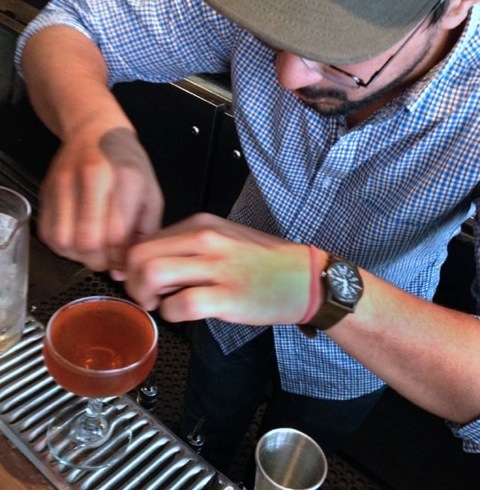Michael Ruhlman's Blog, page 36
September 16, 2013
Pizza Skillet Winners

Eggs are one of the best pizza toppings, period. Photo by Donna Turner Ruhlman.
Pizza pan winners from Thursday’s post were chosen by randomizer:
Anurag Mehrotra, of Athens, GA
Two favorites: one is grilled eggplant and feta topping. The other is a butter chicken sauce with chicken tikka/ tandoori chicken.
Laura Jane Elgass, of Forest Park, IL
Probably not original, but for making good use of seasonal ingredients I made a charred corn and cherry tomato pizza with goat cheese, arugula and (ahem, aged) balsamic vinegar the other night. It was pretty tasty! Otherwise, any pizza with prosciutto or good Italian sausage is a winner in my book.
Matt (who preferred not to share his name, which is fine by me as long as he shares his pizza)
Spread caramelized onions over the dough and then add some sauteed chard, goat cheese, and sausage.
Thanks to all the rest. Many intriguing ideas. Below are a few more of the ones that caught our attention. Kudos to Debby for the schmaltz suggestion! And I suppose it’s too much to hope that the first suggestion below forgot to leave out his first name, carlos.
danger
I haven’t made pizza at home lately because of some upsetting dough experiences, but the most madcap thing I ever made was something like an okonomiyaki pizza. I minced shrimp and flash fried them with ginger garlic and a little plum sauce and made a sauce consisting of peanut butter, soy sauce and sriracha. Spread the sauce on, standard Mozzarella, top with shrimp and fresh slivers of carrot and a ton of green onion. It was wonderfully strange.
sillygirl
Every so often I must make a pizza with a topping of cauliflower, anchovy paste, garlic, currants, capers, red pepper flakes, cilantro and mozzarella – so tall it must be eaten with knife and fork. Yum!!!
MD
Roll out the dough thin. Brush some olive oil over the dough, top with thinly-sliced prosciutto and pear slices, and sprinkle with Gorgonzola cheese (not too much!). The prosciutto crisps, the pear softens, and the thin crust will get crispy too. My favorite!
Daryl September 12, 2013 at 10:17 am
Brussel sprouts, sausage, roasted red peppers, garlic, olive oil and fontina cheese (no
red sauce).
Debby
Use chicken schmaltz in the crust, then no cheese (I’m kosher), but home made tomato sauce, charred onions, mixed mushrooms and pulled chicken
BDW
Fresh tart Michigan wild blueberries, smoked duck, and goat cheese on a thin crust with a tomato sauce made with a bit of fresh rosemary. Top with a little bit of aged provolone. This is by far my favorite pizza, and the tart, tiny wild blueberries are the key. It’s just not the same with the big sweet conventional type.
Kirk Samuels
I have two favorite pizza creations. The first is a German-style pizza with a caraway rye crust, grilled bratwurst, sharp mustard, sauerkraut and Emmenthaler cheese. The second is a standard thin white crust topped with roasted garlic in olive oil, duck confit, arugula, and Parrano cheese.
Lori Hogenkamp
Pizza French Fries: Bake fries in olive oil, salt, pepper. Use a mix of fresh roasted tomoatoes (w/fresh herbs, honey, balasamic, OO, red pepper flakes) pureed with vinegar and honey and ketchup. Sprinkle with parmesan.
Emil Gercke
Two favorite things with pizza; a sauce made of roasted butternut squash instead of tomato , and caramelized eggplant with any other favorite toppings.
The photo above is from Ruhlman’s Twenty, which has the pizza with eggs recipe.
Looking forward to Chicago events tomorrow (still tix available for Balena lunch, I believe) and Milwaukee event Weds!
If you liked this post, read:
My recent Le Creuset posts on the mini-cocotte: baked eggs, seafood terrine, pan-frying: fried chicken, and the croque madame.
Here are the best places you can get pizza in the USA.
Dessert pizza not such a bad idea after seeing these pastry pies.
Leave it to the Japanese to come up with a fast food chain called Megaburgerpizza, that makes burgers sandwiched between two pizzas.
© 2013 Michael Ruhlman. Photo © 2013 Donna Turner Ruhlman. All rights reserved.
September 13, 2013
Friday Cocktail Hour: Old Infatuation

Wilmer Nolasco, a server and bartender at ‘Cue in the West Village, makes a fat-washed Rye Manhattan. Photo by Donna Turner Ruhlman.
Lollygagging in the West Village a few weeks ago, Donna and her pal Lee wandered into the Fatty ‘Cue, and there found one of the servers experimenting with fat-washed rye. I had that very week been working with a schmaltz-washed rye (whiskey infused with the fat’s flavor), so I took it as an omen owing to my wife’s unfailing good karma. She fired off some quick shots and I asked Wilmer, above, for the story and the results. Herewith the Friday cocktail, a spicy take on the classic Manhattan that morphed into a kind of Old-Fashioned, thanks to the ingenious Massa Syrup, and Fatty ‘Cue’s “master fat,” combination of fat from various meats, clarified. This drink takes some planning, so if you’re drinking along with the Friday Cocktail hour, in lieu of the Old Infatuation, I recommend a classic Manhattan or the Rye-Old Fashioned, linked to below.
by Wilmer Nolasco
The inspiration for me was to explore the flavor profiles of southeast Asia in a way that was slightly different from what we normally concentrate on at the restaurant.
Upon doing a little research I found a few different dry curry recipes and upon discovering what I thought would work best, I created a syrup that was derived from a Massaman style curry.
As for the whiskey, the ratio is 3:1—I used 24 ounces of whiskey to 8 ounces of the Master Fat. Let it sit for 48 hours, making sure to agitate it at least 4 times a day. After the 48 hours, stick it in the freezer so the fat separates from the whiskey and freezes. I remove the fat, pass the whiskey through cheesecloth and it comes out nice and clean and tasty!
When Donna came in to Fatty ‘Cue and saw me making the drink, the idea for the drink was a Manhattan. Upon testing more and more and playing around with different variations of the Manhattan cocktail we started to notice a certain spiciness to the drink that we at first thought was coming from the syrup we developed for the drink. We then realized that it was the seasonings we use for the smoked meats (duh!).
Rather than shy away from the spice level and try to mask it with different combinations of vermouths, we decided it was best to highlight that spice by omitting the vermouth altogether and adding Bittermens Hell Fire bitters and accentuating the earthy notes from the syrup with Bittermens ‘Tiki bitters.
Oh, and we have a name for the drink! It’s called Old Infatuation!

Cheers.
The Old Infatuation
2 ounces fat–washed Rye Whisky (we used Old Overholt)
0.5 ounce Massa Syrup (recipe below)
6 drops Bittermens Hellfire Habanero Shrub extract
6 drops Bittermens ‘Elemakule Tiki Bitters
Lemon twist for garnish
Build in a mixing glass, stir, and strain into a lowball with one ice cube. Some times it’ll go into a double rocks with a large-format sphere ice cube, garnish with an expressed lemon twist.
Massa Syrup
1/2 tablespoon whole black peppercorns
4 cinnamon sticks
6 cardamom pods
2 tablespoons whole coriander seeds
16 whole cloves
5 whole allspice berries
2 cups brown sugar
2 cups water
1 tablespoon ground mace
For the syrup, take all of the components except for the brown sugar, water, and the mace and lightly toast them in a shallow pan until they start to release their essential oils and become aromatic. Transfer the spices to a pot where you’ll add the remaining ingredients and cook until you get a gentle rolling boil. When you achieve that, transfer to another container and put into an ice bath.
Let it sit in the ice bath for 2 hours and strain through a cheesecloth or chinois.
If you liked this post, read:
My other cocktails that feature whiskey or rye: Rye Old-Fashioned, Meyer Lemon Fig, and Whiskey Sour.
Watch the History of Whiskey from the History Channel.
Is rye whiskey back in fashion in the United States?
Two James Spirits in Detroit is whipping up their own brand of American rye.
© 2013 Michael Ruhlman. Photo © 2013 Donna Turner Ruhlman. All rights reserved.
September 12, 2013
Le Creuset Cast Iron Pizza & Giveaway!
Here’s the latest Le Creuset technique video: pizza. So easy and delicious. Make a big batch of dough ahead of time, then portion it and freeze it so you can make pizza whenever the whim strikes! (Note: technique begins at 1:11 of the video.)
And even better, Le Creuset is giving away three—count ‘em, THREE!—of these pans! To enter you need to leave a comment with your most original idea for homemade pizza, or tell me your favorite pizza to make at home, or the one, after watching the video, you most want to try. Right this minute I’m hankering for a bacon and egg pizza! (Be sure to leave an email that works so I can contact you; U.S. entries only, alas.)
And here’s the link to the potluck entry page.
All the technique videos are archived on the Le Creuset site here.
Pizza
1 recipe bread dough from Ruhlman’s Twenty (see below)
2 plum tomatoes, stem ends removed, cut into ¼-inch slices and salted
8 ounces grated mozzarella
½ cup basil chiffonade
tomato sauce (see below)
2 ounces sliced salami
Put your pan into the oven and preheat the oven to 450°F/232°C 30 to 40 minutes before making the pizza.
After the dough has risen, re-knead it and divide it into two or three equal pieces (two will give you a thicker crust). Shape each into a disc and wrap and freeze any dough you won’t be using.
Stretch or roll one piece of dough into a 6-inch disc, cover with a towel, and let rest for 10 minutes more.
Stretch or roll it into a 12-inch thin pizza crust.
Remove the pan from the oven and put your dough into it, spreading it out if necessary so that it covers the bottom of the pan.
For the first pizza, pizza margherita, spread the sliced tomatoes across the dough, leaving a 1-inch rim. Cover with half of the mozzarella.
Return the pan to the oven, reduce the heat to 375°F/190°C, and cook until the dough is cooked and the cheese is melted, 20 to 30 minutes. Remove the pizza to a cutting board and top with the basil. Cut into four to six pieces.
For the second pizza, salami pizza, spread 2 to 4 ounces of tomato sauce on the dough when it’s in the pan, leaving a 1-inch rim. Spread most of the remaining cheese over the sauce. Cover the cheese with the salami. Sprinkle with the rest of the cheese.
Return the pan to the oven, reduce the heat to 375°F/190°C, and cook until the dough is cooked and the cheese is melted, 20 to 30 minutes. Remove the pizza to a cutting board. Cut into four to six pieces.
Makes two pizzas; each pizza serves two
Pizza Dough
4 cups flour
1½ cups water
1 teaspoon active dry yeast
2 teaspoons kosher salt or coarse sea salt
Combine the flour, water, yeast, and salt in the bowl of a stand mixer fitted with a dough hook. Mix on medium speed until the dough is smooth and elastic, 5 to 10 minutes. Depending on the size of the bowl, you may need to stop the mixer and remove the dough from the dough hook if the dough is not developing thoroughly. When the dough looks smooth, cut off a piece and stretch it. If it stretches to the point of transparency, it’s mixed enough. If not, continue mixing until it will.
Remove the bowl from the mixer and cover it with a pot lid or plastic wrap. Allow the dough to rise until it has doubled in size and does not spring back when you push your finger into it, 2 to 4 hours.
Turn the dough out onto a work surface and knead it to release the gas and redistribute the yeast. Cut the dough in 2 pieces and press each half into a disk. Cover the disks with a towel and allow to stand for about 15 minutes.
Tomato Sauce
1 Spanish onion, diced
2 tablespoons butter
kosher salt
1 (28-ounce can) whole peeled tomatoes or 2 pounds Roma tomatoes
Optional:
1 bunch fresh oregano or 1 tablespoon good-quality dried oregano
2 bay leaves
1 tablespoon fish sauce
Sauté the onion in the butter over medium heat until translucent, hitting it with a four-finger pinch of salt as you to.
Puree the tomatoes using a blender (if using fresh tomatoes, roast them at 425°F/218°C for 20 minutes). You can puree them in the can using a hand blender if you first pour some of the tomato juice into the pan with the onions.
Add the tomatoes to the onions and bring to a simmer. Reduce the heat to low and cook for 1 hour. Add any or all of the optional aromatics.
Remove the oregano stems and/or bay leaves before using.
Makes about 2½ cups of sauce
If you liked this post, take a look at these links:
My recent Le Creuset posts on the mini-cocotte: baked eggs, seafood terrine, pan-frying: fried chicken, and the croque madame.
An interesting post on a pizza snob’s view on toppings.
Here are seven different types of pizza from around the world.
Check out these terrible pizza toppings … well, maybe.
© 2013 Michael Ruhlman. Photo © 2013 Donna Turner Ruhlman. All rights reserved.
September 11, 2013
Chopping Chives

Freshly chopped chives. Photo by Donna Turner Ruhlman.
When I was working on the Ad Hoc at Home cookbook with Thomas Keller and Dave Cruz, they showed me this excellent method of chopping chives. Wrap a bundle of chives in a damp folded towel and then cut. It solves two problems: you don’t crush them as you can when they rest flat on the board; and you don’t wind up with long strings of half-cut chive where they knife didn’t go all the way through. You end up with PERFECT chives. It’s also cleaner generally. I love this technique.
If you liked this post, read:
My past post on drying herbs from your garden.
Spillover from the bacon photo: bake some cheddar, bacon, and chive biscuits.
Anna Hewitt discusses making container herb gardens for those who lack space or are city dwellers.
Making candied herbs shared by blogger Shuna Lydon of Eggbeater.
© 2013 Michael Ruhlman. Photo © 2013 Donna Turner Ruhlman. All rights reserved.
September 10, 2013
Bacon

Because. Photo by Donna Turner Ruhlman.
Is this being mean?
Happy Tuesday.
If you liked this post, read:
DIY: Home-Cured Bacon
Candied Bacon Ice Cream recipe from David Lebovitz.
Bourbon Bacon Jam from Evil Shenanigans. Sounds odd, but it’s good.
The revised and updated Charcuterie has just been published.
© 2013 Michael Ruhlman. Photo © 2013 Donna Turner Ruhlman. All rights reserved.
September 9, 2013
Oyster Shells by Donna
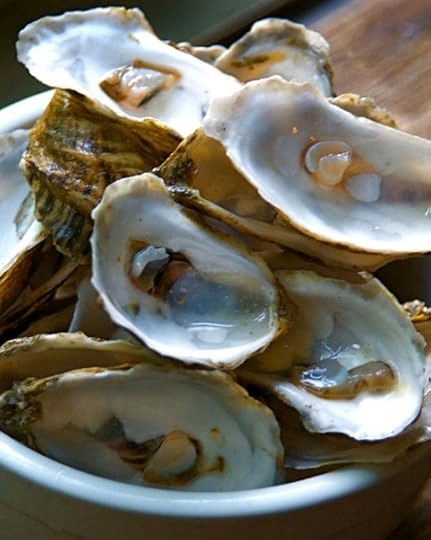
Oysters shells. Photo by Donna Turner Ruhlman.
To help us enjoy our 50th and 51st birthdays, our friend Ingrid sent us some exquisite oysters from Maine. After we’d eaten them, perhaps still delighting in the pleasure, Donna became enthralled with the shells. Me too, and I just wanted to put this photo up. Because.
In October, Brian Polcyn and I will be traveling to Ingrid’s territory for demos and cooking of the noble pig, not only to promote the new and revised edition of Charcuterie, but also to benefit Ingrid’s Island Culinary & Ecological Center. Can’t wait!
If you have access to pristine oysters but have never shucked before, you will need a shucking knife (about the cost of an oyster and widely available), and this good video shows how to do it.
If you liked this post, read:
My past post on a proper crab boil.
Learn about the oyster regions of North America.
Saveur examines various types of North American crabs.
Northeast Fisheries Science Center to better understand living marine resources of the Northeast.
© 2013 Michael Ruhlman. Photo © 2013 Donna Turner Ruhlman. All rights reserved.
September 6, 2013
Friday Cocktail Hour: The Perfect Mojito
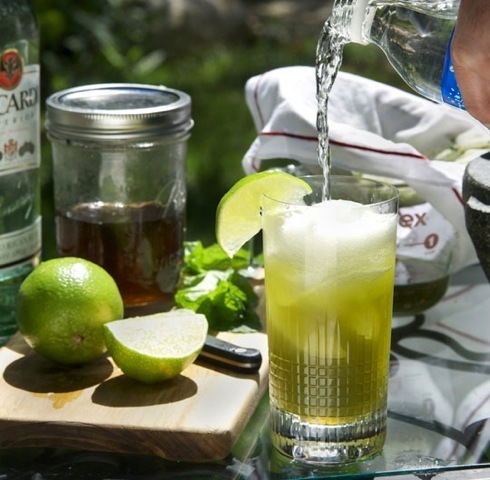
Mojito. Photo by Donna Turner Ruhlman.
I love the clean and pure daiquiri, nothing more than a rum sour. I love a mint julep for its power and herbal freshness. But one thing I don’t like is large fragments of leaves floating in my drink and ever threatening to catch on my front tooth mid-conversation.
I felt like a daiquiri last weekend and made some hastily. I wanted to perfect it. To get more depth from the sugar, I made a simple syrup of brown sugar (equal parts water and brown sugar, heated to dissolve the sugar, then cooled). I pulverized the mint in a mortar, then let the rum soak with it to infuse. Then I strained the rum through a cloth. I combined it all and topped it with sparkling water.
It seemed to me the perfect mojito, and still does.
Mojito
2.5 ounces rum
20 to 30 mint leaves, ground to a paste in a mortar
1 ounce lime juice (juice from half a lime)
1 ounce brown sugar simple syrup
Seltzer water, as needed
Lime wedge for garnish
Pour the rum over the mint in the mortar. Stir and let it sit for 5 or 10 minutes, then strain the rum through a cloth.
Combine the rum, lime juice, and simple syrup in a highball glass. Fill the glass with ice, top with sparkling water, and garnish with the lime wedge.
If you liked this post, read:
My past posts with rum include the Dark and Stormy, Man About Town, and Sour Cherry Daiquiri.
Rum and its history from Salon magazine.
Hemingway loved a great mojito; learn what other writers enjoyed drinking.
Portside Distillery here in Cleveland makes various types of rums; and Cleveland Whiskey makes bourbon; small spirit companies are booming throughout the country.
© 2013 Michael Ruhlman. Photo © 2013 Donna Turner Ruhlman. All rights reserved.
September 5, 2013
Meet Lois Baron, Queen of Schmaltz
After giving me a lesson in how thin I needed to roll the dough to make a proper knish, my neighbor Lois sat down with me in my kitchen to tape the audio for a planned iPad app called The Book of Schmaltz. I had intended to use only the audio, but now that the app is temporarily unavailable because of the publication of the hardcover book, I find Lois’s words too engaging (and funny) to hide. And so here I present her thoughts on schmaltz, chicken fat rendered with onion, against the backdrop of our messy kitchen backdoor area. She is an articulate woman who waxes beautiful on this most ethereal of fats.
And, from this humble goy to Jews far and wide, L’Shanah Tovah. May your year be fruitful and filled with schmaltzy goodness.

Schmaltz: Chicken fat rendered with onion, strained. Aka liquid gold. Photos by Donna
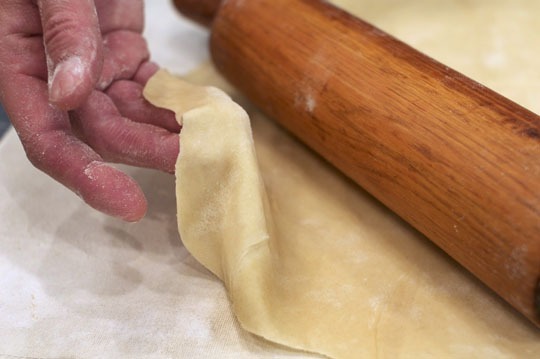
Knish dough, enriched with schmaltz, rolled super thin to wrap potato and gribenes.
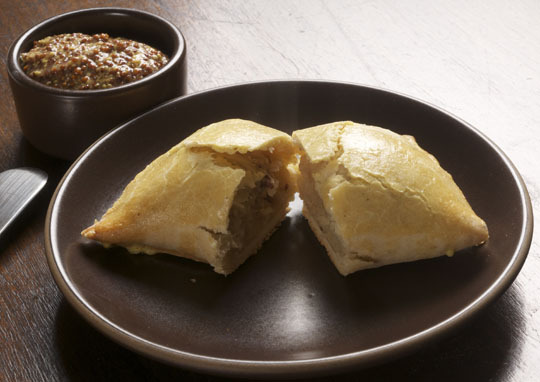
Homemade knish, with thanks to Lois Baron
If you liked this post, read:
My post on the importance of food writing.
Looking for more books on Jewish cuisine? Check out Arthur Schwartz’s Jewish Home Cooking: Yiddish Recipes Revisited.
Chabad.org has an entire forum dedicated to kosher dishes.
Epicurious features some of my recipes from Schmaltz.
© 2013 Michael Ruhlman. Photo © 2013 Donna Turner Ruhlman. All rights reserved.
September 3, 2013
Revisiting the Importance of Food Writing

Poring over Modernist Cuisine to review for The New York Times, a daunting task!
Photos by Donna Turner Ruhlman.
I published this last year in the Huffington Post on September 24, 2012, and it got such a strong response, I’m reposting it. Also I’m under the gun for two major book projects and two freelance assignments all due at once for some reason, not to mention sundry book promo interviews; I guess summer is over and fall is officially here. Sigh.—M.R.
The Importance of Food?
I’ve been thinking about this a lot lately, and not least of all because I’ve always strived to distance myself from the pigeonhole called “food writer.” Food is important, obviously. If we don’t have it, we die. Writing about something so important should need no justification. And yet if I were called, say, an “environmental journalist,” wouldn’t that sound somehow more substantial, more serious than being a “food writer”? Isn’t exploring the effect of increasing levels of carbon dioxide on our environment or the ecological impact of harnessing wind energy to reduce our reliance on fossil fuels more important than writing about, say, Salmon Tartare in a Savory Tuile with Red Onion and Crème Fraîche? A journalist embedded with American troops in Afghanistan versus a writer who waxes poetic on the glories of veal stock?
There are, of course, diverse and good reasons to write about food, from aesthetic pleasures to consumer advocacy. Many books in which food is the central subject have had an extraordinary impact on the way we think about food, and our lives–Michael Pollan’s Omnivore’s Dilemma and Eric Schlosser’s Fast Food Nation, of course, but also books by writers such as Paul Greenberg, Tracie McMillan, Mark Kurlansky, Barry Estabrook, Rowan Jacobsen (there are now too many to cite) that explore how our world is changed by the way we grow, distribute, buy, and cook food.
Food writer Monica Bhide posed this question–does food writing matter?–on her blog, and I was heartened to see many smart responses from writers. Chief among the commenters was journalist and author Annia Ciezadlo, author of Day of Honey: A Memoir of Food, Love, and War (in which she writes, “I cook to comprehend a place I’ve landed in”). In response to Bhide’s question, Cizadlo simply quoted George Orwell, from The Road to Wigan Pier, a book about class structure in 1930s England:
“I think it could plausibly be argued that changes of diet are more important than changes of dynasty or even of religion. The Great War, for instance, could never have happened if tinned food had not been invented. And the history of the past four hundred years in England would have been immensely different if it had not been for the introduction of root-crops and various other vegetables at the end of the middle ages, and a little later the introduction of non-alcoholic drinks (tea, coffee, cocoa) and also of distilled liquors to which the beer-drinking English were not accustomed. Yet it is curious how seldom the all-importance of food is recognized. You see statues everywhere to politicians, poets, bishops, but none to cooks or bacon-curers or market-gardeners.”
I’m delighted to have these words disinterred from a 75-year-old book, because it states what should be obvious. Food is all-important. To write about what is all-important should need no justification.
And yet it still seems to.
Because food is all around us, everywhere, easy and cheap, we’ve taken it for granted. Do you ever stop to wonder how it is that you can buy pea pods 365 days a year, whether you live in Maine, Montana, or Manitoba? Few do. The fact is, most people don’t think about food until they don’t have any. Then it’s pretty much all they can think about.
And we don’t think about food obsessively until it starts making us sick, which is what has happened in this country. Our food is making us sick in myriad ways. Our toddlers develop allergies unheard of when we were growing up. Children develop a type of diabetes once seen only in late adulthood. Obesity is rampant. And because of this we’ve become so hyperconscious of what we eat that we believe all kinds of nonsense. Dieticians once preached that eggs were bad for you–eggs! People far and wide still believe that fat is what makes you fat and that cutting salt and fat from one’s diet will make a healthy person even healthier. The way we produce food is destroying the land, polluting rivers and oceans, debasing the animals we raise for food and the workers who slaughter and process them. Nothing good comes from shitting where you eat, and this is what America has been doing for half a century.
People ask me the reason for today’s intense interest in food and chefs and cooking. A serious book with a jokey title was written to explore just this, David Kamp’s superb United States of Arugula. But I don’t think you need a whole book that includes Eisenhower’s highway system, war veterans returning from Europe, the increasing accessibility of international travel, and the impact of television to explain it. For me, it all comes down to the fact that we lost something vital when we stopped cooking our own food in the 1950s. And not cooking our own food has increasingly made us sick, to the point that we’ve become obsessive about food.
Obsession over food has had some positive results, such as the call to eat local, sustainable, and humanely raised food. But obsession often leads to really bad ideas, like 100% raw diets and any number of loopy food imperatives otherwise intelligent people (see Steve Jobs) put themselves on. I’d love to see a study of life-long raw-dieters and life-long vegans and the effects on their reproductive systems. I’d wager they’d quickly self-select themselves out of the population (which is why, perhaps, we don’t see many people who are life-long vegans and raw-foodists).
I believe it’s foolish to deny that we are human, which we do when we embrace nonhuman behavior.
Almost everything our bodies and minds are capable of is represented in some part of the animal kingdom; primates even demonstrate theory of mind, and one species has nonreproductive sex, once thought to be an exclusively human activity. There are only two activities that set us apart, and we should take heed. First, humans are the only animals that cook their food. If we do not cook our food, or stay close to people who do, life is unsustainable; there have been no groups documented to have survived for long on an exclusively raw diet (convincingly documented in Richard Wrangham’s book, Catching Fire: How Cooking Made Us Human).
Second, humans are the only animals that generate narrative–that is, tell stories. Telling and hearing stories is, in fact, one of our primary, life-long activities, something we do all day and throughout the night. Sleep scientists have shown that if we are prevented from telling ourselves stories when we sleep, if our brains are prevented from dreaming, life is unsustainable. Cooking and telling stories. That’s what makes us human.
So telling stories about food and cooking is not only natural, it’s necessary for our survival. It’s important to understand how something that is essential to our humanity and our well-being affects all other aspects of our lives and our humanity. No one questions the need to explore string theory and economic policy, or asks for justification for art and literature. But people do question the seriousness of writing about food. I can go weeks without quantum physics or a good movie. Can’t say that about food. I dream of a day when we no longer need to be obsessed with food, because that would mean that we had figured it out, we had all come to a common understanding of how to grow our food, distribute it, and consume it in ways that don’t make us sick and crazy, but rather healthy and happy; that, rather than being guilty, fearful, and intimidated by food, we instead rejoiced in food; that we would cook together, with our families and friends, and then sit down to share this cared-for food and tell each other the stories of our day.
This I think I was meant to do. To connect food with what I believe is fundamental to our lives and our happiness, to our humanity, and to do so through story. I will continue to write about many things, but I will never stop writing about food and cooking, what food and cooking means, to make it clear that cooking dinner is not a chore or a hassle, not simply the fulfillment of a bodily need, or even an indulgence, but is in fact fundamental to our humanity and to the health of our children and our children’s children.
It’s all-important.
If you liked this post, read:
MFK Fisher’s The Art of Eating.
Elizabeth David’s An Omelette and a Glass of Wine.
My advice to aspiring food writers.
© 2013 Michael Ruhlman. Photo © 2013 Donna Turner Ruhlman. All rights reserved.
August 30, 2013
Friday Cocktail Hour: A Gibson
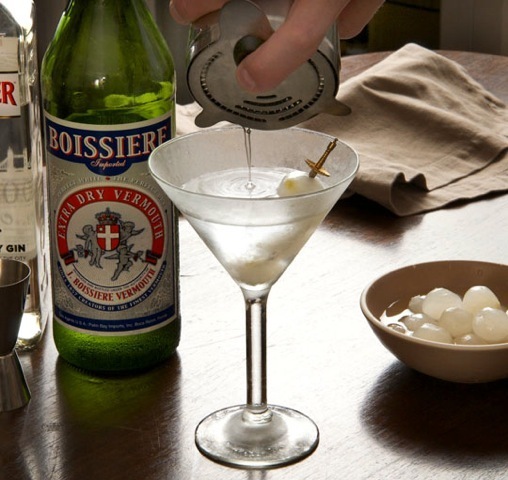
Another classic: The Gibson/Photo by Donna Turner Ruhlman
The creators of last week’s cocktail on fat-washed spirits, schmaltz, and rye, noted that the onion (which worked perfectly with the schmaltzy rye) recalled a Gibson. Loving the interconnectedness of cocktails, that is the choice for today’s Friday Cocktail Hour. The Gibson is a martini garnished with onion, and I like to underscore the difference between it and a martini by adding some of the pickling liquid. Because it features gin, use a good gin such as Beefeater, my fave. Same vermouth ratio as a martini, 20%, though vary this according to your tastes.
Do you hear anyone asking for a vodka Gibson? Do you hear bartenders, upon being asked for a Gibson, respond, “Vodka or gin?” I think not.
This is a serious cocktail with a sweet-sour-onion garnish, reflecting the serious and bittersweet recognition that it is Labor Day weekend and summer deliquesces.
The Gibson
80 grams
16 grams
10 grams
Pickled onions for garnish
or by volume
2.5 ounces gin
1 tablespoon vermouth
1 teaspoon pickle juice
Pickled onions for garnish
Combine all ingredients but the onions in shaker, fill it with ice, and stir or swirl for 60 to 90 seconds.
Strain the cocktail into a cold martini glass.
Prepare for fall.
If you liked this post, take a look at these links:
My past posts that include gin are the Hasty Negroni, Boulevardier, and Tom Collins.
Make your own Gibson pickles with Mrs. Wheelbarrow’s juniper pickling recipe.
Check out the Evans & Peel Detective Agency, independent cocktail bar and restaurant in West London.
The Museum of the American Cocktail blog.
© 2013 Michael Ruhlman. Photo © 2013 Donna Turner Ruhlman. All rights reserved.
Michael Ruhlman's Blog
- Michael Ruhlman's profile
- 354 followers




